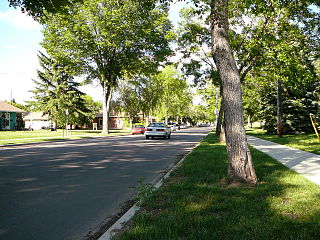
Spruce Avenue is an irregular shaped residential neighbourhood in Edmonton, Alberta, Canada. The neighbourhood is home to Kingsway Mall, the Glenrose Rehabilitation Hospital, the Northern Alberta Institute of Technology, the Norwood Extended Care Hospital, Spruce Avenue Community Center, Spruce Avenue Junior High School, and St. Basil Catholic Junior High School. The neighbourhood takes its name from the former designation of 114 Avenue.
Greenfield, formerly known as Petrolia, is a residential neighbourhood located in southwest Edmonton, Alberta, Canada. There is a small shopping centre, Petrolia Shopping Centre, located in the neighbourhood. The neighbourhood was named for Herbert Greenfield, the Premier of Alberta from 1921 to 1925, during the reign of the United Farmers of Alberta political party.
Elmwood Park is a neighbourhood in north central Edmonton, Alberta, Canada.

Holyrood is a residential neighbourhood in the Bonnie Doon area of south east Edmonton, Alberta, Canada. The name, Holyrood, is an anglicisation of the Scots haly ruid.

Idylwylde is a residential neighbourhood in south east Edmonton, Alberta, Canada.
Prince Rupert is a triangle-shaped residential neighbourhood in north west Edmonton, Alberta, Canada. Prince Rupert is located within the old Hudson's Bay Reserve and was developed after the end of World War II. The neighbourhood is bounded on the south by 111 Avenue, on the west by 121 Street, and on the northeast by Kingsway Avenue.
Westwood is a residential neighbourhood in north central Edmonton, Alberta, Canada. It is bounded by Yellowhead Trail to the north, 107 Street and 106 Street to the west, 118 Avenue to the south, 97 Street to the east. The Edmonton City Centre Airport is located to the west, while the Northern Alberta Institute of Technology and Kingsway Mall are located to the southwest.
Royal Gardens is a residential neighbourhood in south west Edmonton, Alberta, Canada. The neighbourhood is bounded on the north by Whitemud Drive, on the east by 111 Street, on the south by 40 Avenue, and on the west by 119 Street/121 Street.
Forest Heights is a residential neighbourhood in east central Edmonton, Alberta, Canada that overlooks the North Saskatchewan River valley to the north and west. Four bridges provide access to destinations on the north side of the river.
Montrose is a residential neighbourhood in north east Edmonton, Alberta, Canada.
Allendale is a residential neighbourhood located in south west Edmonton, Alberta, Canada. The neighbourhood is named for the Allen family, who owned a farm there. It was annexed by the City of Strathcona in 1907.
Hazeldean is a residential neighbourhood in south east Edmonton, Alberta, Canada. The neighbourhood overlooks the Mill Creek Ravine.
Balwin is a residential neighbourhood in north east Edmonton, Alberta, Canada. Originally part of North Edmonton, the area was annexed by the City of Edmonton in 1912.
Empire Park is a residential neighbourhood in southwest Edmonton, Alberta, Canada. A major shopping centre, Southgate Centre, is located at the west end of the Neighbourhood.
King Edward Park is a residential neighbourhood on south east Edmonton, Alberta, Canada. The neighbourhood was originally annexed by Edmonton in 1912.
Lauderdale is a residential neighbourhood in north west Edmonton, Alberta, Canada. It is named for "James Lauder who farmed and owned land near the neighbourhood before the turn of the 20th century".
Sherbrooke is a residential neighbourhood in north west Edmonton, Alberta, Canada.
Killarney is a residential neighbourhood located in north east Edmonton, Alberta, Canada. While the area became part of Edmonton in 1913, residential development did not occur until the 1950s and 1960s.
Kilkenny is a residential neighbourhood in north east Edmonton, Alberta, Canada. Most of the development in the neighbourhood occurred during the 1960s and 1970s. It was named after Kilkenny in Ireland.

Queen Alexandra is a mixed residential and commercial neighbourhood in south west Edmonton, Alberta, Canada. The neighbourhood, once part of the City of Strathcona, is named for Alexandra of Denmark. The north edge of the neighbourhood, along Whyte Avenue is part of Old Strathcona, a popular commercial and cultural area of Edmonton.







